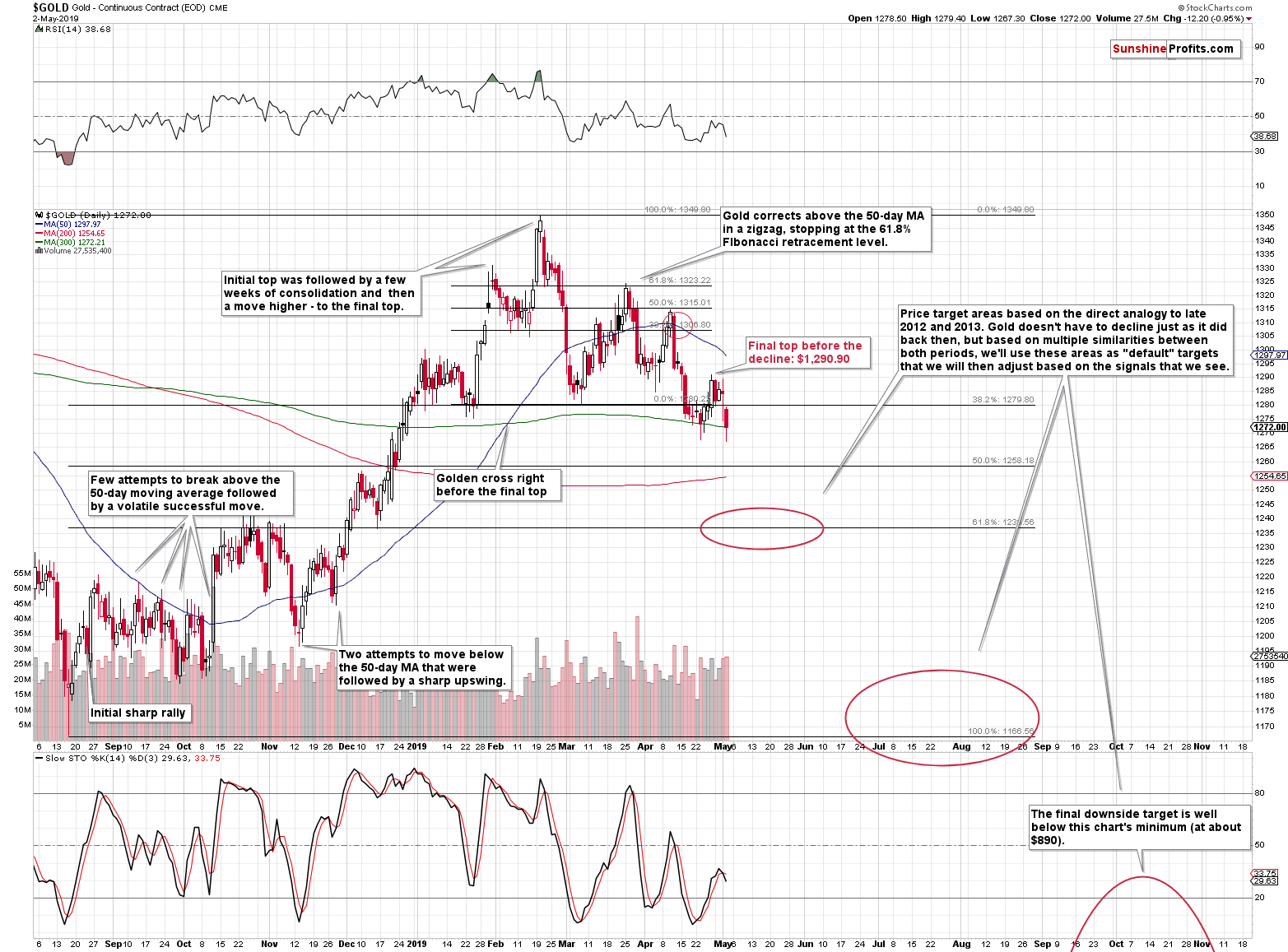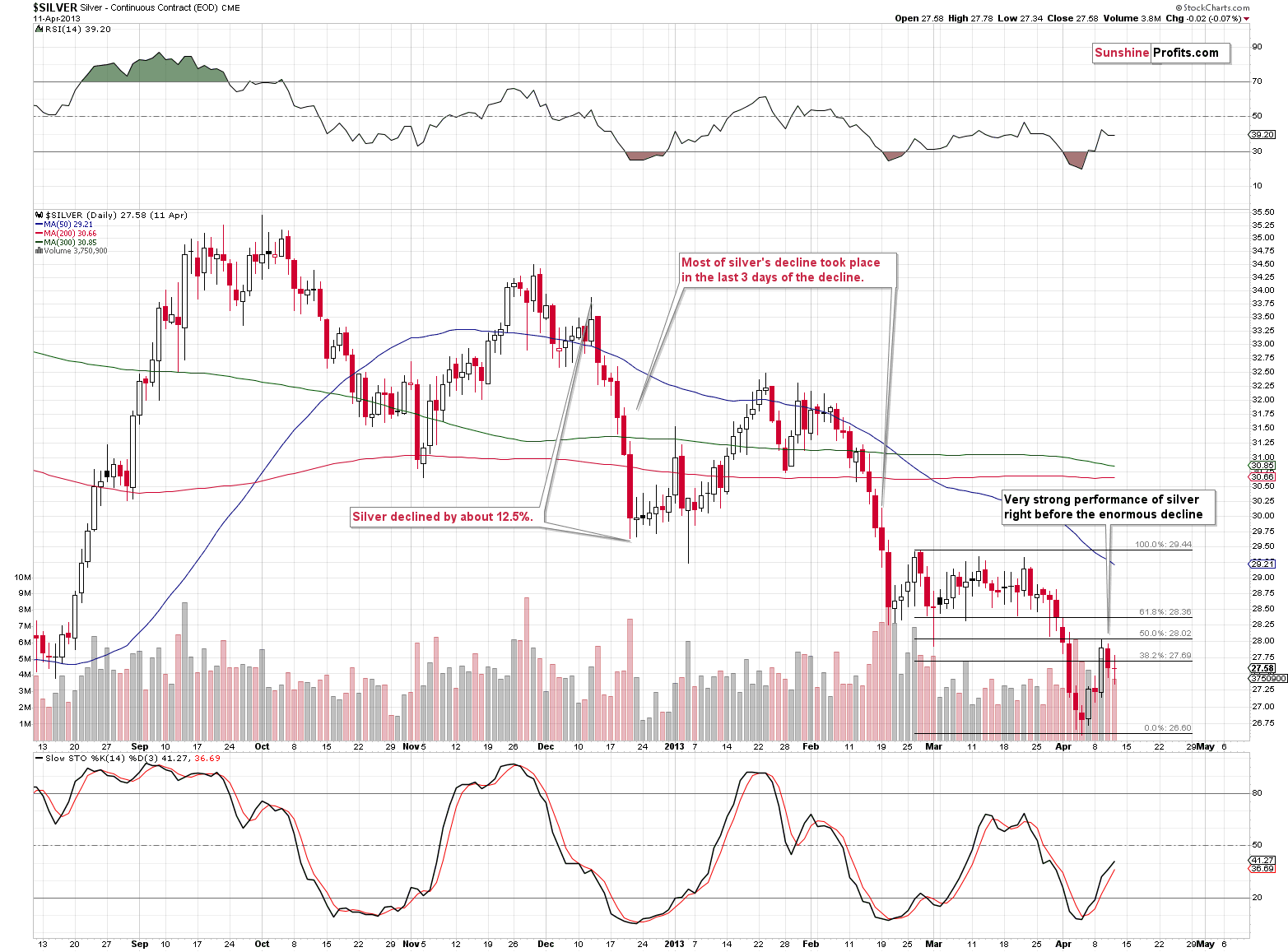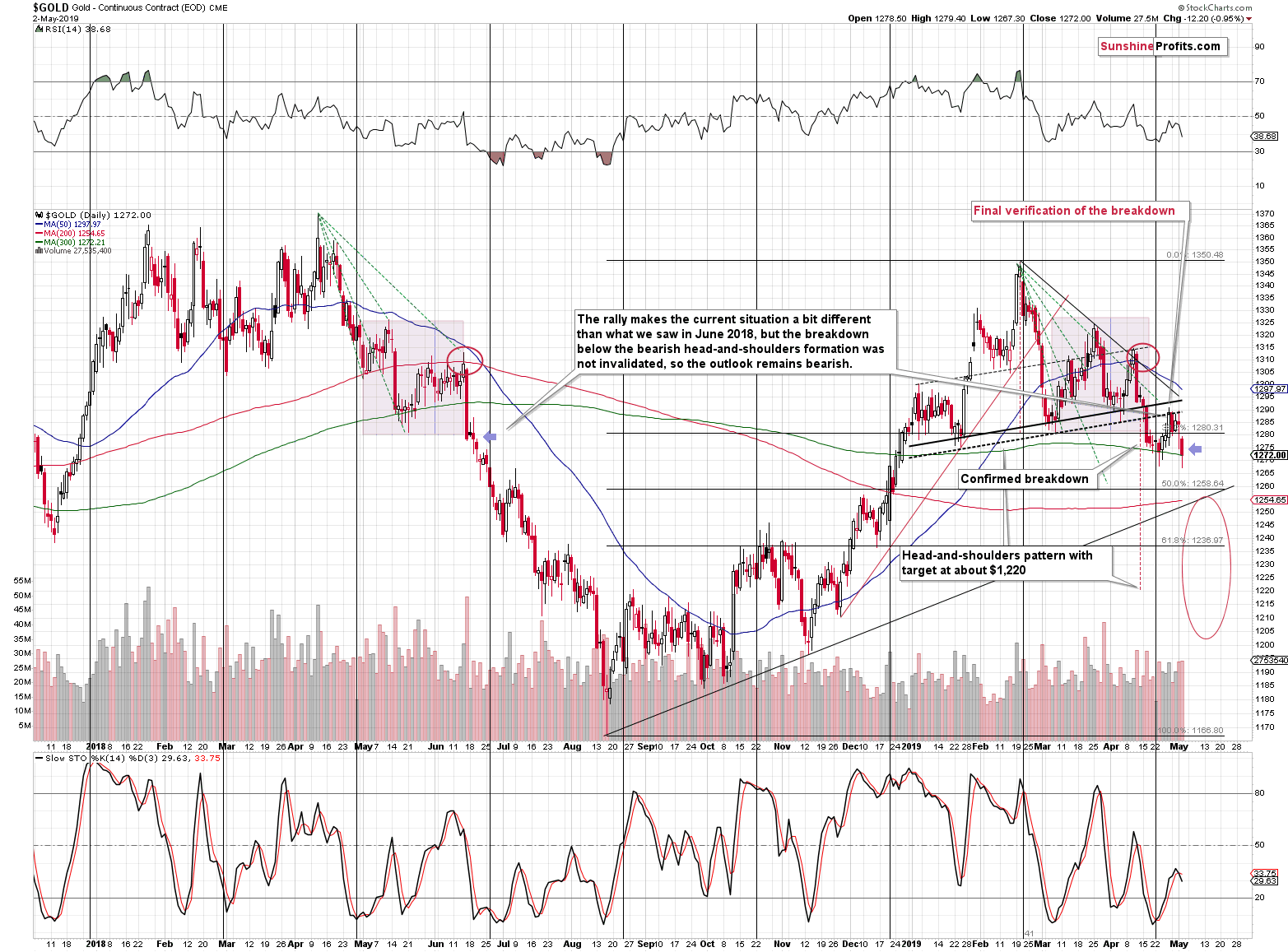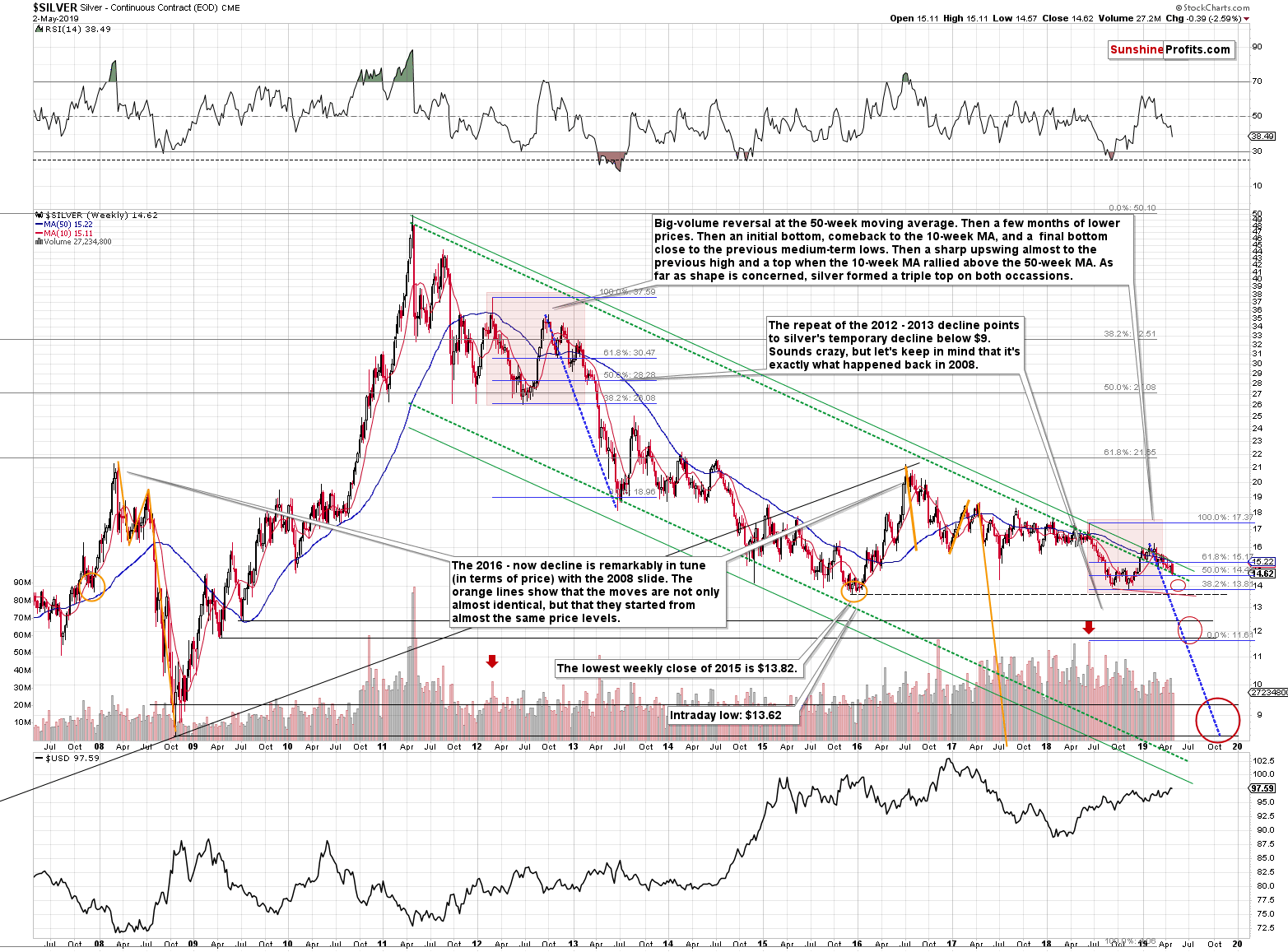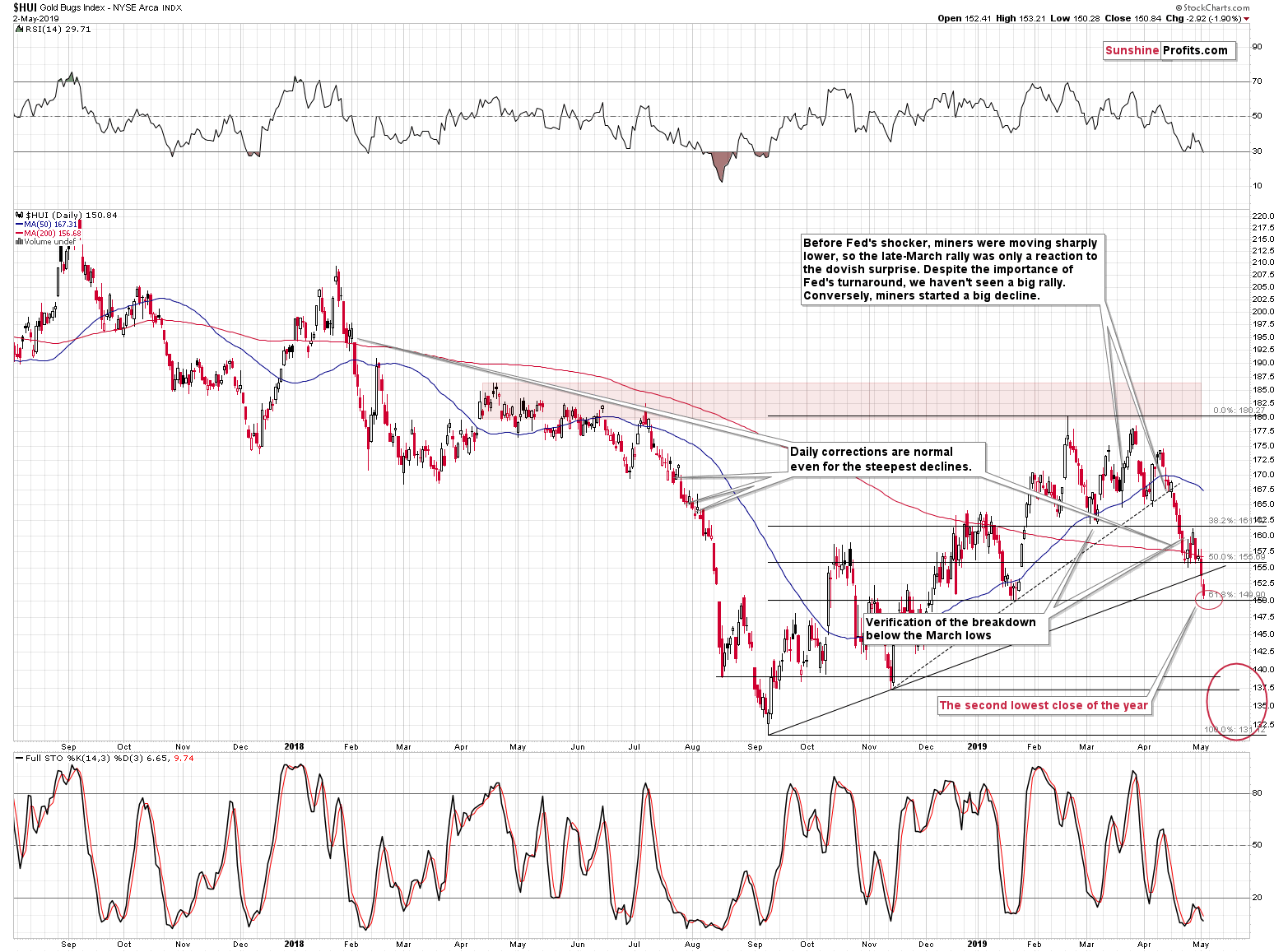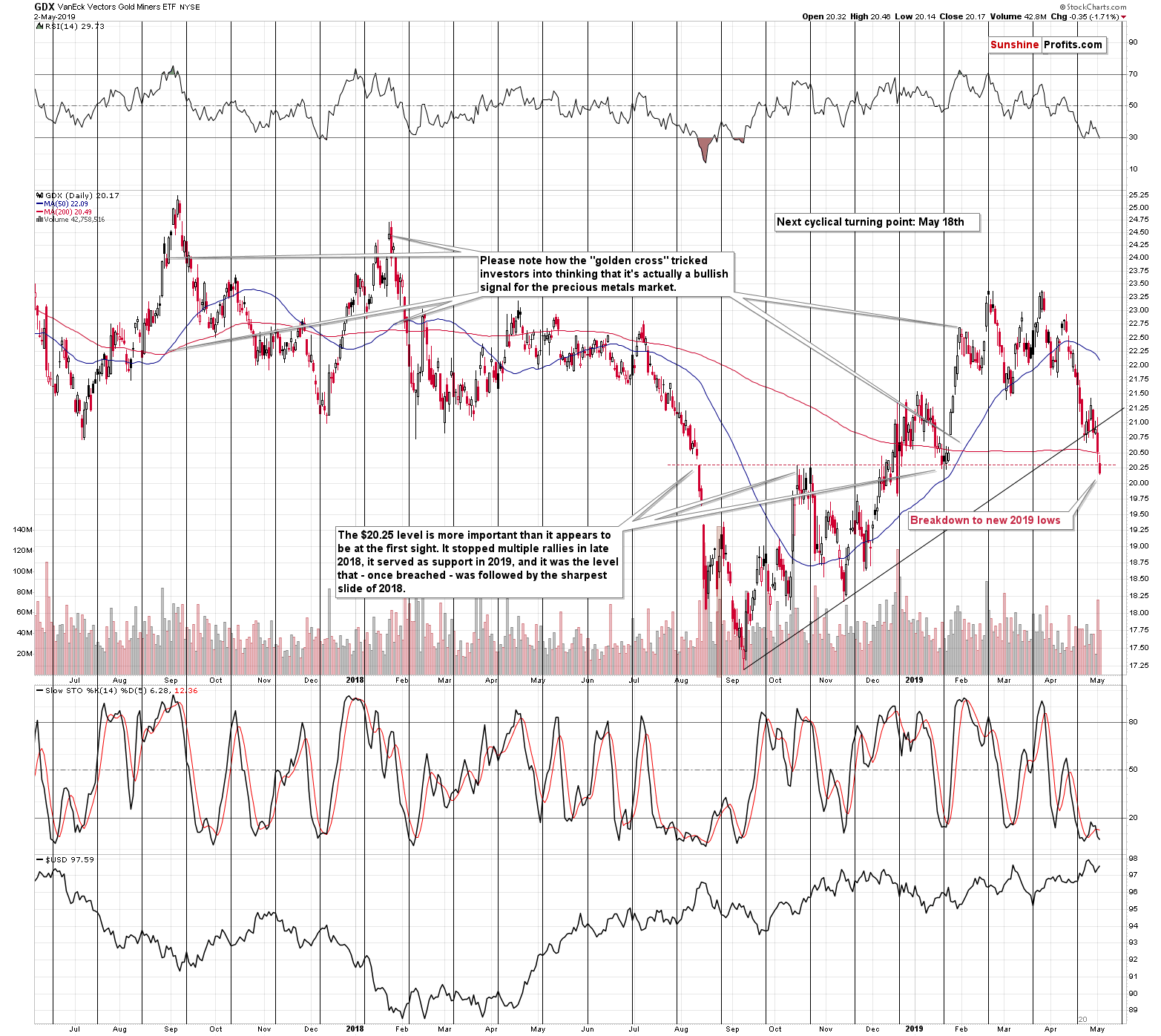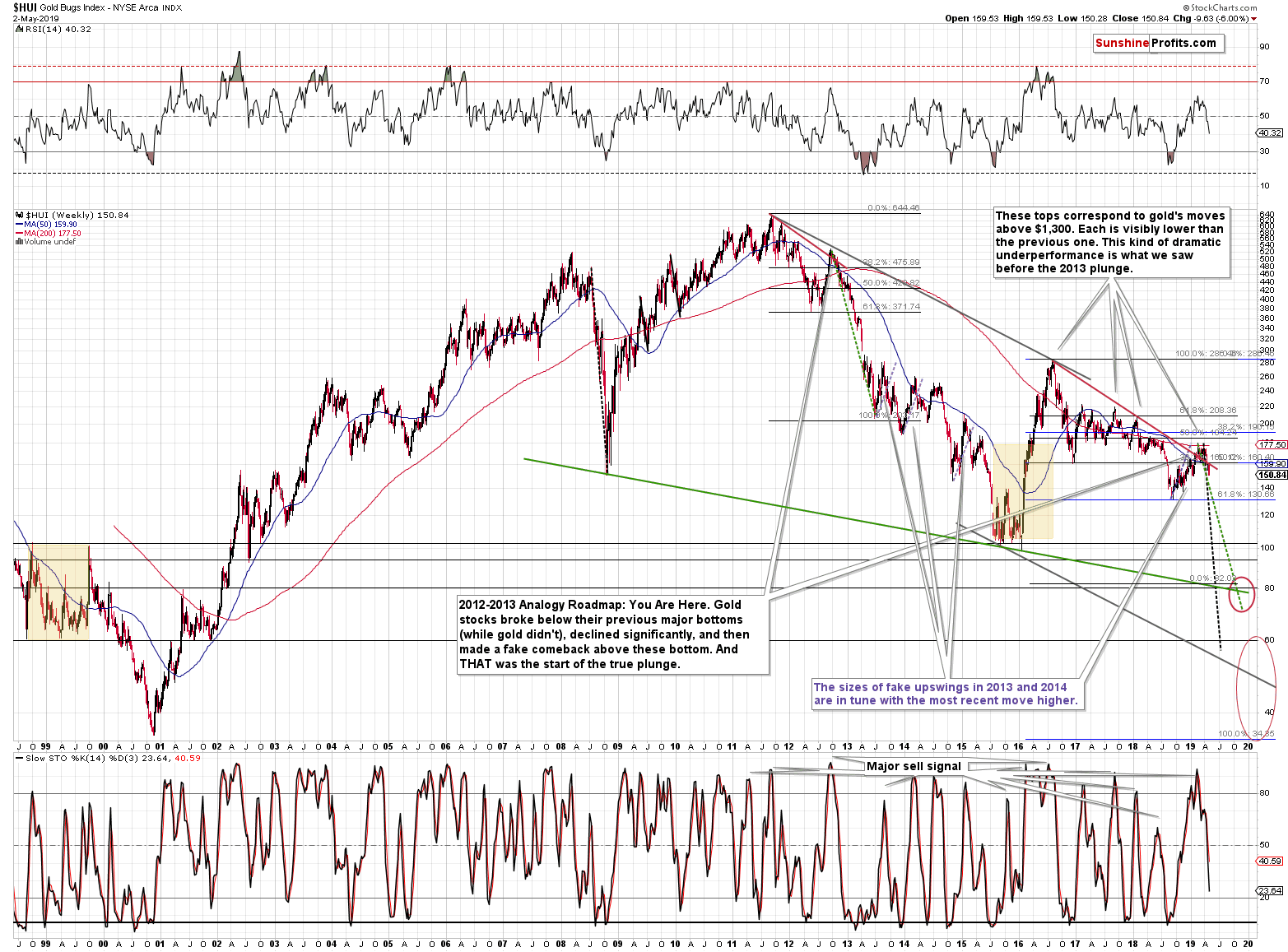Briefly: in our opinion, full (250% of the regular size of the position) speculative short position in gold, silver, and mining stocks is justified from the risk/reward perspective at the moment of publishing this Alert. We are moving the take-profit level for silver lower.
Silver just broke below its important support line, while gold and the GDX ETF moved to new yearly lows. The outlook for the precious metals sector has been extremely bearish and yesterday's action simply confirms it. Not just that, there's something more. Based on silver's breakdown, it's current price level and analogy to how precious metals declined during the 2012-2013 slide, it seems that our previous near-term target for silver was set too high. Let's take gladly what the market is willing to give us as the profit potential of this decline seems to be even bigger than previously expected.
Let's jump into details.
Starting with Gold
The current situation in gold is very similar to what we saw in December 2012 and the above charts features the short-term details. We discussed the long-term details in March and the short-term price action in gold has been confirming them.
The long-term analogies are present in gold, silver, and gold stocks, so the relative performance of the above to each other should be similar as well. The above confirms our quite distant target for the mining stocks. But what about the implications for the silver market?
Back in December 2012, gold declined by about 5.2%, counting from the very last short-term top to the initial bottom. This suggests the target of about $1,225 for gold. Based on the technical support levels, it seems that the more likely target is at about $1,240.
Moving back to silver, let's see how it performed in December 2012.
Silver and the Lessons from Gold
Silver declined by about 12.5%. This means that silver more than doubled gold's move. It declined 12.5 / 5.2 = about 2.4 times more.
Now, based on the 61.8% Fibonacci retracement, and the October and November 2018 highs, it seems that the next strong support for gold is at about $1,240. There is also the rising support line at about $1,255, but it's too close to the current prices to be meaningful. Gold's price target based on the confirmed head-and-shoulders top formation is at about $1,220 and $1,255 is not even close to that. In other words, it's very unlikely that gold broke below a medium-term head-and-shoulders pattern and verified this breakdown over about 2 weeks only to go on and decline merely by $30 (gold completed the pattern at about $1,285).
The starting price of the current short-term decline is $1,290.90. Taking $1,240 as the target gives us a situation in which gold declines by about 3.94%
Now, since back in 2012, silver multiplied the decline by the factor of 2.4. Perhaps we will see something similar also this time. Multiplying 3.94% by 2.4 equals 9.456%, which is how much (approximately) we should expect silver to decline from its recent high.
The most recent high in the white metal was $15.12. A decline by 9.456% from $15.12 means that silver would form its next short-term bottom at about $13.69.
Yes, this is below the 2018 lows, but let's keep in mind that silver temporarily broke below the September 2018 lows in November, so breaking down temporarily below previous important lows would not be something unexpected for silver to do.
In fact, the above-mentioned lows create a declining support line, which is currently at about $13.60, which is another reason to expect silver to decline visibly below $14.
If you noticed that the above analysis misses something important, you are right. It's missing the big picture.
The Long-term
The late 2015 bottom is $13.62, which is extremely close to the above-mentioned declining red support line. This combination is very close to the $13.69 level that we got based on the relative valuation; let's keep in mind that we used a lot of approximation when calculating this price. For instance, the precise target for gold is actually $1,237, not $1,240. Consequently, the $13.69 value should be used just as a ballpark confirmation and the technical levels based on the above long-term silver chart should be used as the final target prices.
So, all in all, it seems that silver will not end this short-term downswing at the 2018 lows, but close to the 2015 lows. We are adjusting our take-profit prices accordingly.
The above would imply the gold to silver ratio at about 90-91, which is something that could actually take place temporarily. We would be likely to see a correction in both: metals and the ratio, but as far as the price extremes are concerned, the above is clearly doable for the ratio, given the recent breakout above the previous long-term highs.
There's one more thing about silver to discuss. It's the analogy in terms of time. Back in December 2012, it took silver 6 days for the decline to complete. Silver is now after 4 days of decline. This means that we are most likely to see the next short-term bottom early next week.
As far as gold is concerned, we have very little to add to what we wrote yesterday - the situation continues to develop in tune with our expectations. Gold is declining after completing, confirming, and verifying the breakdown below the neck level of the head-and-shoulders top pattern. The fact that gold broke to new 2019 lows is notable, but it didn't change much in terms of the outlook as that has already been very bearish beforehand.
The breakdown in mining stocks has bigger implications.
Gold Miners: the Cherry on the Cake
Both: the HUI Index, and the GDX ETF moved visibly below their rising support line and the latter even moved to new yearly low. At this time, GDX's 2019 performance would be a one big reversal candlestick. The HUI Index's close is the second lowest of the year.
The HUI Index is right at our initial target level and while it's still possible that the 61.8% Fibonacci retracement in the HUI will trigger a small correction, we wouldn't bet on it.
The GDX ETF chart shows why. The breakdown was not only below the previous 2019 lows, but also below the $20.25 level. This level is important due to three major reasons. Listed in order of increasing importance:
- It stopped the January 2019 decline
- It stopped several October 2018 attempts to break higher
- It was the level that - when breached to the downside - was followed by the most volatile decline of the previous year
Gold is just starting its slide and miners are clearly underperforming. In this environment, gold's move to $1,240 or so is likely to be accompanied by sharply lower mining stock prices. The breakdown below $20.25 seems to be the final technical confirmation that we got before miners dive.
Also, if the move to about $18.25 (November 2018 lows) from here seems too big, please keep in mind the big picture.
Even if gold stocks moved to the 2018 lows right away, it would just be a relatively small part of the entire decline that is likely ahead. Yes, we know, it looks unrealistic. That's exactly the point - the prices need to get to unrealistic lows that are scary enough to complete the shakeout. This is how true bottoms form. When the HUI Index was trading above 500, seeing it at 200 or 100 seemed impossible. And yet, that's exactly what happened a few months, and years later, respectively.
The outlook for the mining stocks remains very bearish.
Before summarizing, we were asked what part of the precious metals market is likely to decline the most (and thus which of the short positions has the most upside potential) and we believe our reply might be useful to everyone. In our view, silver and miners have the biggest potential right now due to their relative performance to gold. Gold has lagged behind miners and silver, but it doesn't mean that it will catch up. The breakout in gold to silver ratio clearly shows that silver is set to decline more than gold. And while gold may catch up with mining stocks in a way, it's likely to take place... During the corrective upswing, when miners might also bounce more significantly than gold. During the 2012-2013 decline, silver and mining stocks declined more than gold and we think that the same will also be the case this time. Miners are likely to bounce back sooner than silver and silver might catch up with miners during the final part of a given corrective upswing, but as far as the move lower is concerned, it seems that diversification between different parts of the precious metals market is the way to go. In my gold investment fund, I focus on taking advantage of the decline in silver and in the mining stocks as that's where I see the greatest potential.
Also, we have an interesting non-market fact to share. The American Constitution was the first written national constitution, but do you know what country was the second to adopt its first written constitution? The biggest European country at that time - Poland (precisely, the Polish-Lithuanian Commonwealth). It happened on this day, exactly 228 years ago.
Summary
Summing up, there are multiple short-term and medium-term signs pointing to a powerful slide in the precious metals market in the following months, weeks, and - quite likely - days. In particular, the breakdowns to new yearly lows in gold, silver and the GDX ETF point to much lower prices in the near term. There will likely come a time later this year when we will get in the back-up-the-truck territory with regard to precious metals, but we are not even close to these discounted price levels. However, it looks like the final slide towards them has already started. Based on the likelihood of seeing a temporary turnaround today or next week, we might have a good chance of exiting the current short position or even switching to a long one at that time.
We are moving the profit-take levels lower for silver.
As always, we'll keep you - our subscribers - informed.
To summarize:
Trading capital (supplementary part of the portfolio; our opinion): Full short position (250% of the full position) in gold, silver, and mining stocks is justified from the risk/reward perspective with the following stop-loss orders and exit profit-take price levels:
- Gold: profit-take exit price: $1,241; stop-loss: $1,357; initial target price for the DGLD ETN: $51.87; stop-loss for the DGLD ETN $39.87
- Silver: profit-take exit price: $13.81; stop-loss: $15.72; initial target price for the DSLV ETN: $39.38; stop-loss for the DSLV ETN $26.97
- Mining stocks (price levels for the GDX ETF): profit-take exit price: $18.41; stop-loss: $24.17; initial target price for the DUST ETF: $34.28; stop-loss for the DUST ETF $15.47
In case one wants to bet on junior mining stocks' prices (we do not suggest doing so - we think senior mining stocks are more predictable in the case of short-term trades - if one wants to do it anyway, we provide the details), here are the stop-loss details and target prices:
- GDXJ ETF: profit-take exit price: $26.42; stop-loss: $35.67
- JDST ETF: profit-take exit price: $78.21 stop-loss: $30.97
Long-term capital (core part of the portfolio; our opinion): No positions (in other words: cash)
Insurance capital (core part of the portfolio; our opinion): Full position
Whether you already subscribed or not, we encourage you to find out how to make the most of our alerts and read our replies to the most common alert-and-gold-trading-related-questions.
Please note that the in the trading section we describe the situation for the day that the alert is posted. In other words, it we are writing about a speculative position, it means that it is up-to-date on the day it was posted. We are also featuring the initial target prices, so that you can decide whether keeping a position on a given day is something that is in tune with your approach (some moves are too small for medium-term traders and some might appear too big for day-traders).
Plus, you might want to read why our stop-loss orders are usually relatively far from the current price.
Please note that a full position doesn't mean using all of the capital for a given trade. You will find details on our thoughts on gold portfolio structuring in the Key Insights section on our website.
As a reminder - "initial target price" means exactly that - an "initial" one, it's not a price level at which we suggest closing positions. If this becomes the case (like it did in the previous trade) we will refer to these levels as levels of exit orders (exactly as we've done previously). Stop-loss levels, however, are naturally not "initial", but something that, in our opinion, might be entered as an order.
Since it is impossible to synchronize target prices and stop-loss levels for all the ETFs and ETNs with the main markets that we provide these levels for (gold, silver and mining stocks - the GDX ETF), the stop-loss levels and target prices for other ETNs and ETF (among other: UGLD, DGLD, USLV, DSLV, NUGT, DUST, JNUG, JDST) are provided as supplementary, and not as "final". This means that if a stop-loss or a target level is reached for any of the "additional instruments" (DGLD for instance), but not for the "main instrument" (gold in this case), we will view positions in both gold and DGLD as still open and the stop-loss for DGLD would have to be moved lower. On the other hand, if gold moves to a stop-loss level but DGLD doesn't, then we will view both positions (in gold and DGLD) as closed. In other words, since it's not possible to be 100% certain that each related instrument moves to a given level when the underlying instrument does, we can't provide levels that would be binding. The levels that we do provide are our best estimate of the levels that will correspond to the levels in the underlying assets, but it will be the underlying assets that one will need to focus on regarding the signs pointing to closing a given position or keeping it open. We might adjust the levels in the "additional instruments" without adjusting the levels in the "main instruments", which will simply mean that we have improved our estimation of these levels, not that we changed our outlook on the markets. We are already working on a tool that would update these levels on a daily basis for the most popular ETFs, ETNs and individual mining stocks.
Our preferred ways to invest in and to trade gold along with the reasoning can be found in the how to buy gold section. Additionally, our preferred ETFs and ETNs can be found in our Gold & Silver ETF Ranking.
As a reminder, Gold & Silver Trading Alerts are posted before or on each trading day (we usually post them before the opening bell, but we don't promise doing that each day). If there's anything urgent, we will send you an additional small alert before posting the main one.
Thank you.
Sincerely,
Przemyslaw Radomski, CFA
Editor-in-chief, Gold & Silver Fund Manager



